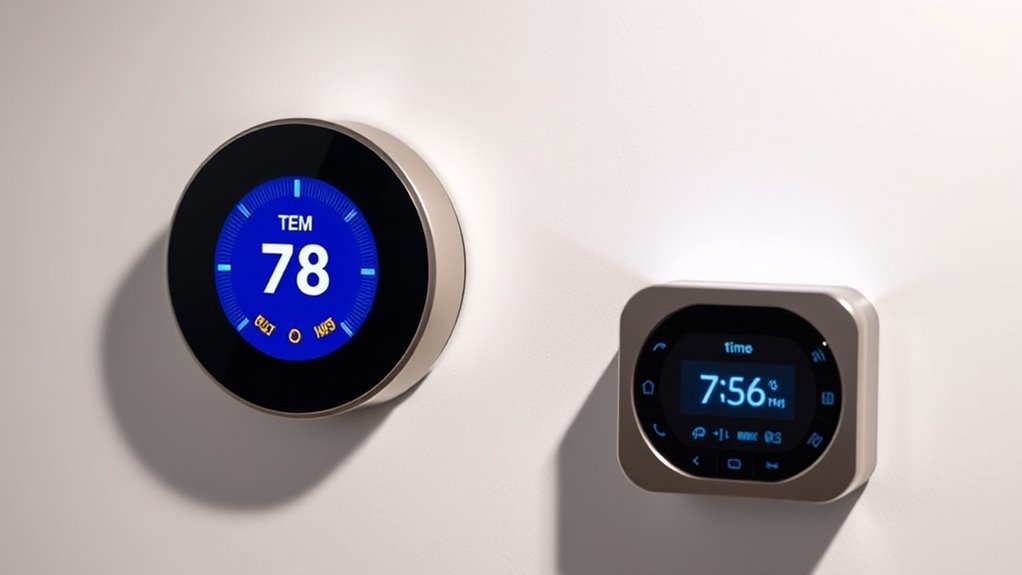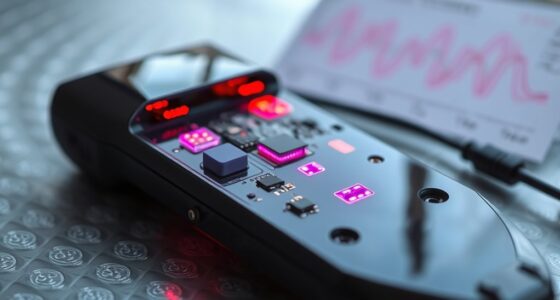Advanced timers and thermostats help you control your home’s heating and cooling systems for better comfort and energy savings. They include mechanical, digital, and smart options that can be programmed or operate remotely through Wi-Fi or voice commands. Choosing the right one depends on your desired features and level of automation. Proper installation, setup, and regular maintenance ensure maximum performance. Keep exploring to discover how these systems can make your home more efficient and comfortable.
Key Takeaways
- Understand the differences between mechanical, digital, programmable, and non-programmable timers to select the best for your needs.
- Learn how smart timers with Wi-Fi and voice control enhance convenience and energy efficiency in home climate management.
- Properly set and schedule advanced thermostats to optimize comfort and reduce energy consumption based on daily routines.
- Know how to troubleshoot and reset timers or thermostats to resolve common issues quickly and maintain system performance.
- Consider noise levels and maintenance practices to ensure quiet operation and long-term reliability of your heating and cooling systems.
Understanding the Role of Timers and Thermostats in Home Climate Control
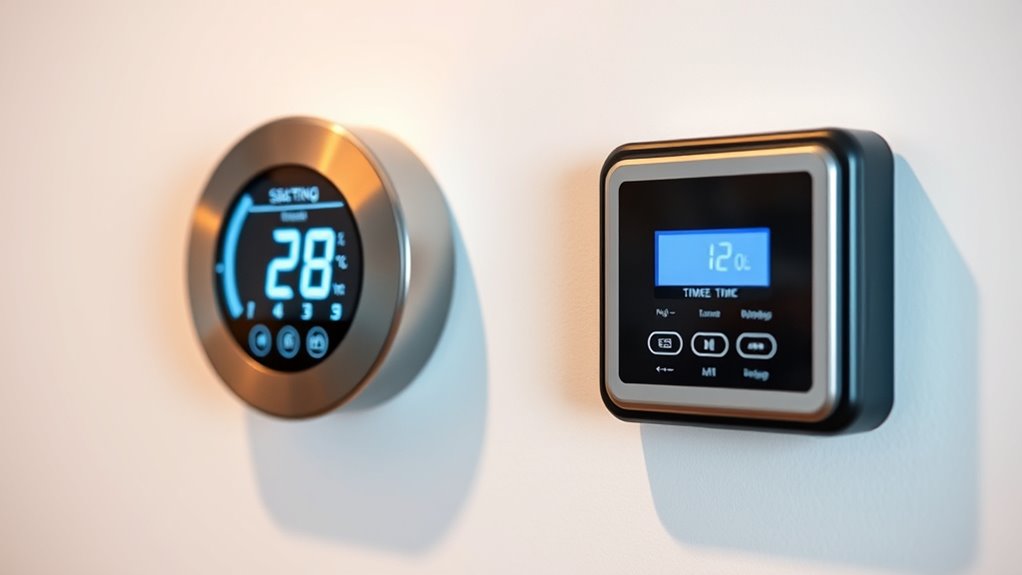
Timers and thermostats are essential tools for maintaining a comfortable and energy-efficient home environment. They help you regulate temperature and humidity levels, directly impacting your indoor air quality. By setting your thermostat, you control when your heating or cooling systems activate, preventing unnecessary energy use. Timers add another layer of control, allowing you to schedule adjustments based on your daily routine. Proper humidity control is crucial for air quality, reducing mold growth and allergens that thrive in damp environments. When your thermostat manages temperature and humidity effectively, you create a healthier living space and lower energy bills. Understanding how home climate control systems work can help you optimize their performance and extend their lifespan. These tools work together to optimize comfort, ensuring your home stays inviting no matter the season.
Types of Advanced Timers and How They Function
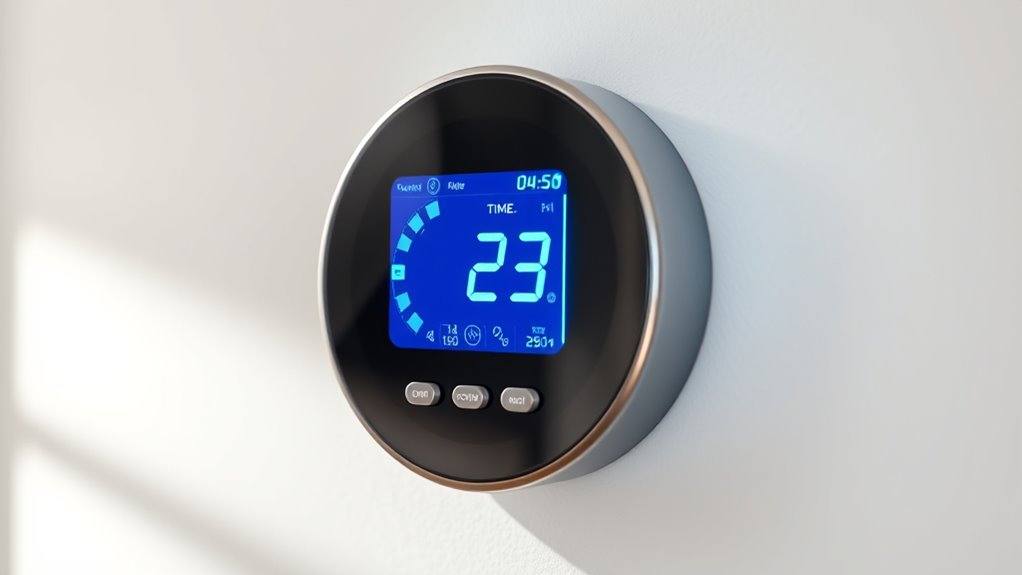
You’ll find that advanced timers come in various types, each with unique ways of controlling your devices. Mechanical timers rely on physical parts, while digital ones use electronic circuits for more precision. Additionally, some timers are programmable or Wi-Fi enabled, offering smart features that make managing your home climate easier. For example, headphone jacks are essential components in connecting audio devices, and understanding their types can help you troubleshoot or upgrade your equipment more effectively.
Mechanical vs. Digital Timers
While both mechanical and digital timers serve the same purpose of controlling devices on a schedule, they operate through fundamentally different mechanisms. Mechanical timers use gears and springs, making them simple and often more durable, but they may lack precise timer accuracy. Digital timers rely on electronic components, providing higher timer accuracy and seamless integration with modern thermostats. Additionally, the choice between them can influence the performance and reliability of your system.
Programmable vs. Non-Programmable
Have you ever wondered how advanced timers differ in functionality? Programmable timers let you set custom schedules, making energy-saving strategies easier to implement. You can program them to turn devices on or off at specific times, optimizing energy use throughout the day. Non-programmable timers, on the other hand, operate on simple, fixed settings without the ability to customize schedules. This makes them less flexible but often more straightforward. When choosing between the two, consider user interface design—programmable timers typically feature digital displays and intuitive controls, making scheduling simple. Non-programmable models might lack this ease of use but are generally more affordable. Your choice depends on whether you prefer customization and convenience or basic, no-fuss operation.
Wi-Fi and Smart Features
Modern advanced timers now incorporate Wi-Fi and smart features, expanding their capabilities beyond basic scheduling. With wireless connectivity, you can control your timer remotely using a smartphone or tablet, no matter where you are. This remote access allows you to adjust settings, override schedules, or turn devices on and off instantly. Smart timers can learn your routines over time, optimizing energy use and comfort automatically. Many also integrate with voice assistants, making control even easier. These features provide convenience and flexibility, helping you save energy and improve home automation. Whether you’re away or just want quick adjustments, Wi-Fi-enabled timers give you full control at your fingertips, making managing your devices more efficient and user-friendly. Proper security measures are essential to protect your smart device connections from unauthorized access.
Different Types of Thermostats and Their Features
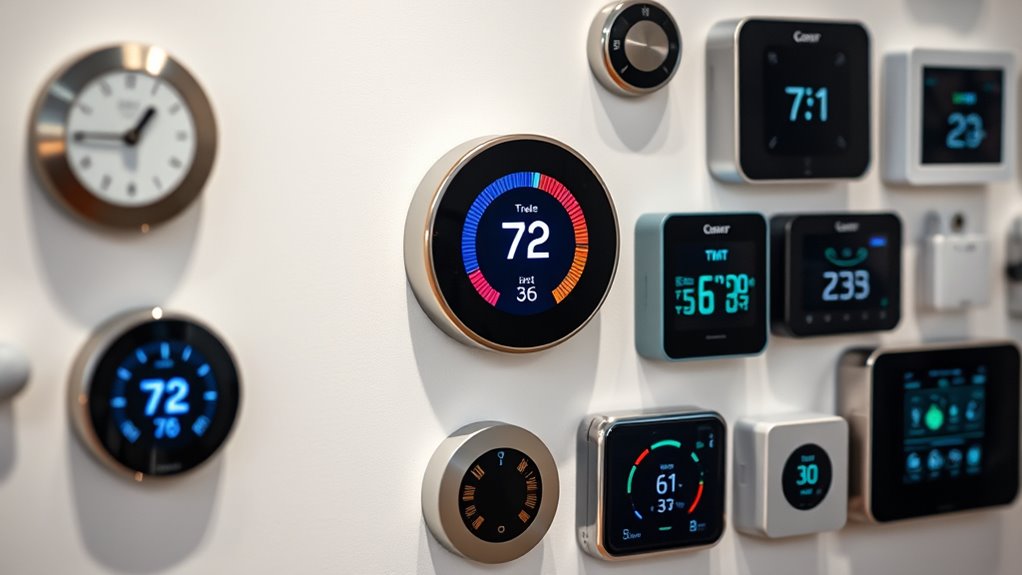
There are several types of thermostats available, each offering unique features to suit different heating and cooling needs. Analog sensors provide simple, reliable readings, often used in manual controls. These thermostats typically feature straightforward dials or switches, making adjustments easy without digital interfaces. Essential oils can be used to create a calming environment around your thermostat area, enhancing comfort.
Key Features to Consider When Choosing a Timer or Thermostat
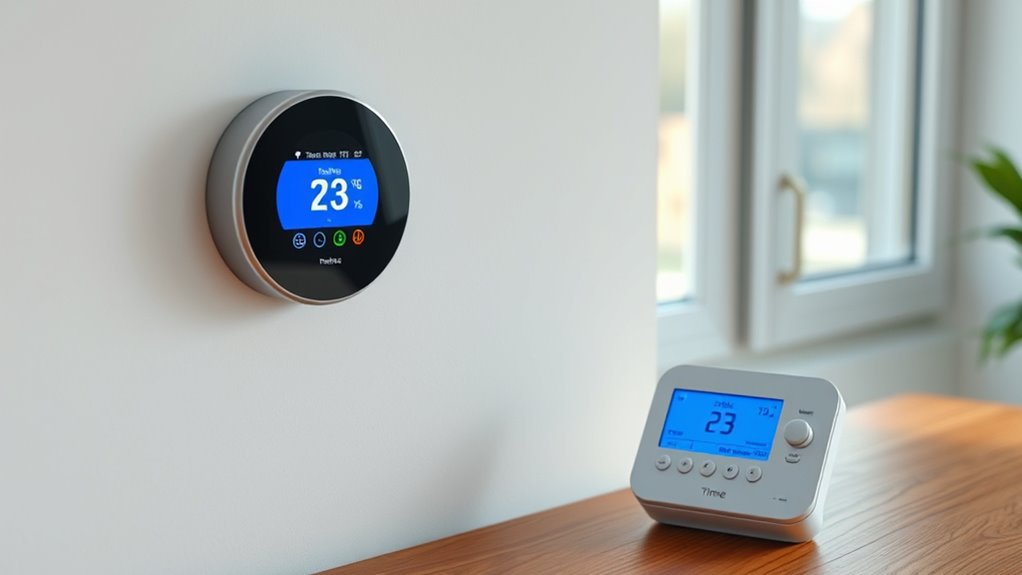
Choosing the right timer or thermostat involves considering several key features that can impact both comfort and energy efficiency. Look for models with effective energy saving strategies, such as programmable schedules or adaptive learning capabilities that reduce unnecessary heating or cooling. A user-friendly interface is essential; it ensures you can easily set and adjust your settings without frustration. Touchscreens, clear displays, and simple menus make daily use more convenient. Consider features like remote access via smartphone apps, which allow you to control your system on the go. Also, check for compatibility with your existing heating and cooling systems. Additionally, understanding GMC tuning techniques can help you optimize vehicle performance and efficiency, paralleling the importance of choosing a thermostat that suits your needs. Ultimately, prioritizing energy saving strategies and intuitive interfaces helps you optimize comfort and reduce utility costs effortlessly.
Installing and Setting Up Your Timer or Thermostat
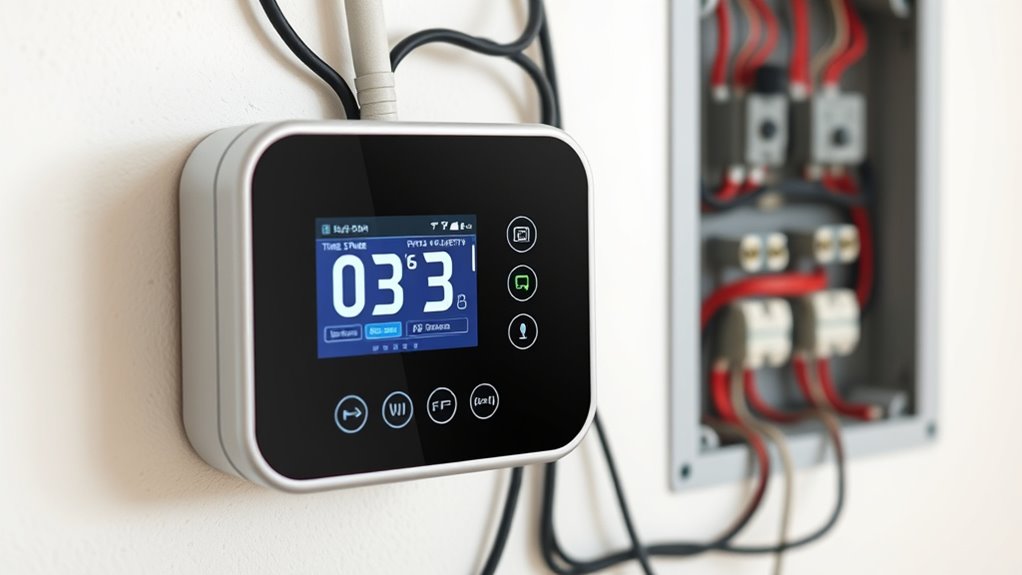
Once you’ve selected the right timer or thermostat, the next step is installing and setting it up properly. Proper installation ensures you enjoy energy saving tips and a seamless experience with user friendly interfaces. Take your time and follow the manufacturer’s instructions carefully. As you set it up, you’ll feel confident knowing you’re taking control of your energy bills and comfort. To make the process easier, keep these in mind:
- Ensure secure mounting for safety and durability
- Connect wiring correctly to avoid malfunctions
- Configure initial settings for peak efficiency
- Remember that understanding how timers and thermostats work can help you optimize their benefits and improve your energy management.
Getting this right means your device is ready to help you save energy effortlessly while providing an easy-to-use interface that simplifies your daily routine.
Programming and Automating Your Heating and Cooling Systems
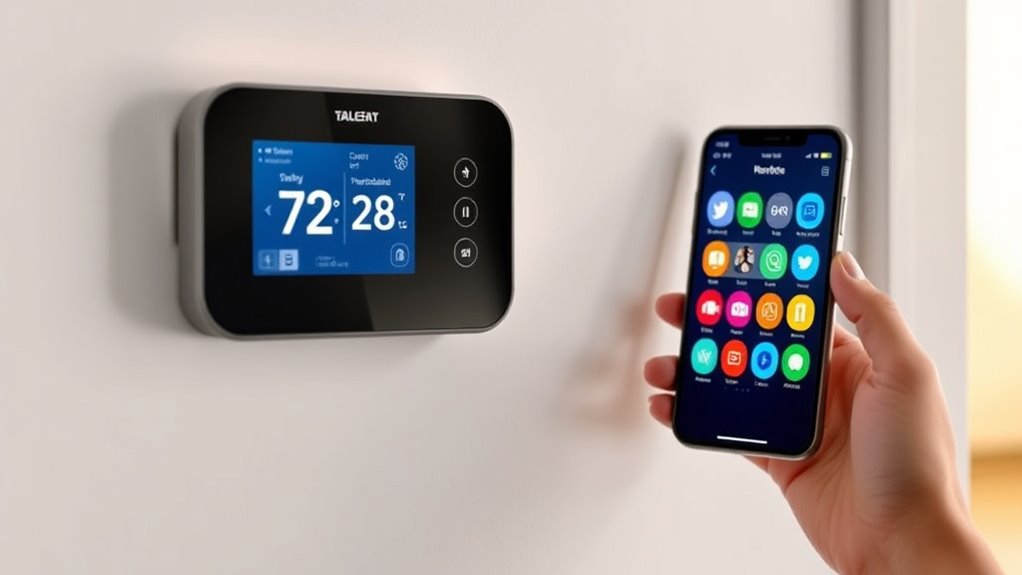
To maximize energy savings and maintain comfort, it’s essential to program and automate your heating and cooling systems effectively. Smart home integration allows you to control your thermostat remotely and set personalized schedules that align with your daily routine. By automating temperature adjustments, you reduce unnecessary energy use while ensuring comfort when you’re home. Utilizing energy consumption monitoring tools helps you track how much energy your systems consume, giving you insights to optimize settings further. Many smart thermostats learn your preferences over time, adjusting automatically for efficiency. You can also create different zones or schedules for various parts of your home, enhancing automation. Additionally, understanding the noise levels of modern heat pumps can help you choose quieter systems that won’t disturb your daily activities. This combination of programming and automation guarantees your systems work smarter, saving energy and keeping your home comfortable.
Tips for Maximizing Energy Efficiency With Timers and Thermostats
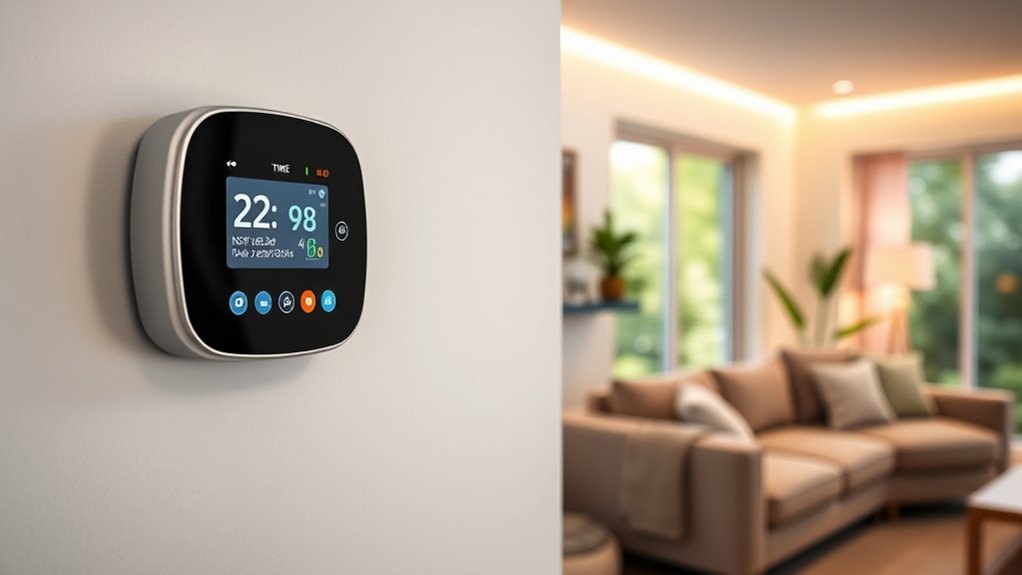
Maximizing energy efficiency with timers and thermostats starts with smartly scheduling your heating and cooling cycles. By setting precise times, you avoid unnecessary energy use and cut costs. Take advantage of energy saving strategies by customizing your system to match your lifestyle and occupancy patterns. Use thermostats with user-friendly interfaces to easily adjust settings without hassle, making energy management simple. Remember:
- Program your system to lower temperatures when you’re not home or asleep, preventing waste.
- Utilize timers to switch systems off during peak hours when cooling or heating isn’t needed.
- Adjust your thermostat gradually to avoid sudden temperature changes, saving energy without sacrificing comfort.
- Being aware of allergy risks associated with certain seeds can help you make safer choices for your household.
These tips help you optimize your system’s performance, reduce energy bills, and support a more sustainable lifestyle.
Troubleshooting Common Issues and Maintenance Tips
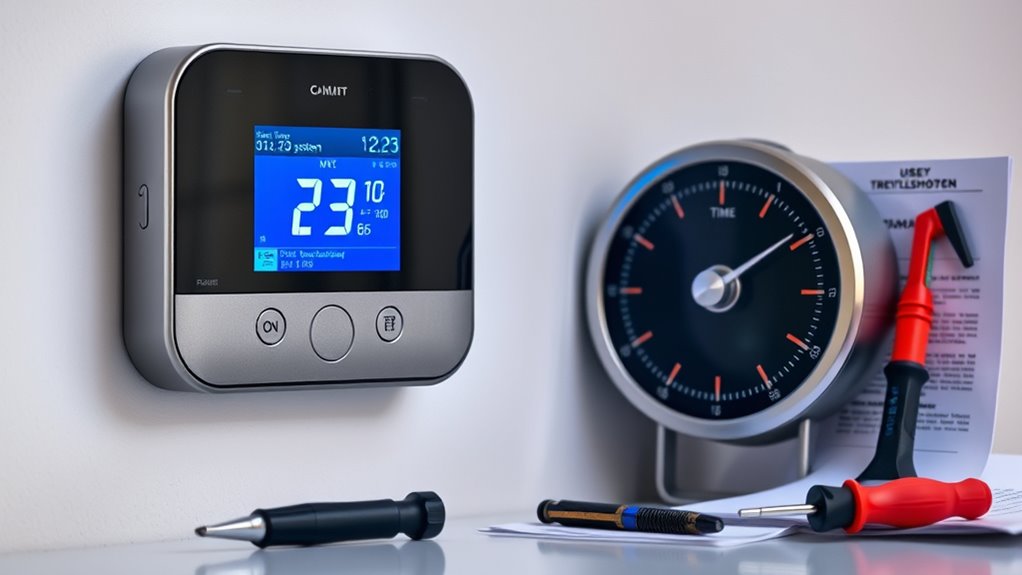
When your timer or thermostat malfunctions, a simple reset often solves the problem. Regular system inspections help catch issues early and keep everything running smoothly. Staying proactive with maintenance guarantees your devices operate efficiently and last longer.
Resetting Malfunctioning Devices
If your timer or thermostat isn’t responding properly, resetting the device often clears minor glitches and restores normal operation. A simple reset device action can fix a device malfunction quickly, saving you time and frustration. To reset your device, locate the reset button—usually a small, recessed hole—and press it with a pin or paperclip. This step can resolve many common issues without needing professional help.
Remember, resetting isn’t a fix-all, but it can bring your device back to life. When you perform a reset, you’re giving it a fresh start. This small step can restore your device’s performance and keep your system running smoothly.
- Feel confident knowing you can troubleshoot on your own.
- Reclaim control over your comfort system.
- Avoid costly repairs with simple maintenance.
Regular System Inspection
Have you ever wondered why your timer or thermostat isn’t working as expected? Regular system inspection is key to catching issues early. Use an inspection checklist to confirm that connections are secure, sensors are clean, and settings are correct. Following a maintenance schedule helps prevent malfunctions and extends device lifespan. Here’s a quick visual:
| Inspection Area | Common Issue |
|---|---|
| Wiring Connections | Loose or corroded contacts |
| Sensors | Dirt or misalignment |
| Display and Controls | Faulty or unresponsive buttons |
| Power Supply | Fluctuations or outages |
Perform these checks periodically to ensure your system runs smoothly. Staying proactive saves time and money, keeping your timer and thermostat functioning reliably.
Frequently Asked Questions
Can Advanced Timers Integrate With Smart Home Systems?
Yes, advanced timers can integrate with smart home systems. You can enjoy seamless smart home integration, allowing you to control your timers remotely through apps or voice commands. Many advanced timers offer remote control features, making it easy to adjust settings from anywhere. This integration enhances convenience, energy efficiency, and automation, so you can manage your heating, cooling, or lighting systems effortlessly and stay connected to your home at all times.
Are Programmable Thermostats Compatible With All HVAC Systems?
Think of your HVAC system as a puzzle. Not all pieces fit every thermostat type, so programmable thermostats aren’t compatible with all HVAC setups. You need to check HVAC compatibility before choosing a thermostat. Some systems, like traditional or older units, might need specific models, while newer ones often work with various programmable options. Always verify your system’s specifications to guarantee a smooth fit and proper function.
How Do I Reset a Malfunctioning Timer or Thermostat?
To reset a malfunctioning timer or thermostat, start with the reset procedures outlined in the user manual. Usually, you’ll press and hold a reset button or turn off the power supply for a few minutes. Troubleshooting tips include checking the batteries, inspecting wiring connections, and ensuring settings are correct. If issues persist, perform a full reset and reprogram your device. This approach helps restore normal operation efficiently.
What Safety Precautions Should I Follow During Installation?
During installation, prioritize safety by turning off power at the circuit breaker to prevent electrical shocks. Follow wiring precautions carefully, guaranteeing all wires are properly insulated and connected according to manufacturer instructions. Use insulated tools and wear safety gear like gloves and goggles. Double-check connections before restoring power, and avoid working alone if you’re unfamiliar with electrical work. These steps help ensure a safe and successful installation process.
Can Timers and Thermostats Be Controlled Remotely via Smartphone?
Yes, you can control timers and thermostats remotely via smartphone control. Many modern devices feature remote access, allowing you to adjust settings from anywhere using your smartphone. You’ll need to connect your device to Wi-Fi and install the manufacturer’s app. Once set up, you can easily change temperatures, schedules, and monitor your system remotely, giving you convenience and better control over your home’s climate.
Conclusion
By understanding advanced timers and thermostats, you can easily optimize your home’s comfort and save energy. Don’t worry if setup seems complex at first—you’ll quickly get the hang of programming and troubleshooting. With the right tools and knowledge, you’ll enjoy a cozy, efficient home year-round. Remember, investing a little time now means fewer headaches later, and you’ll reap the benefits of smarter climate control every day.
